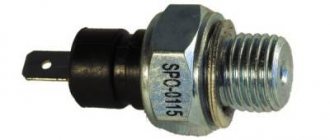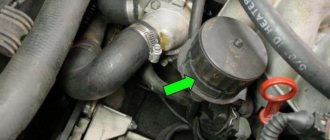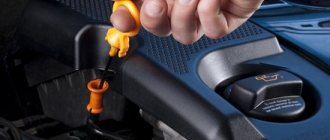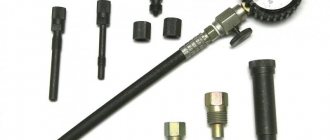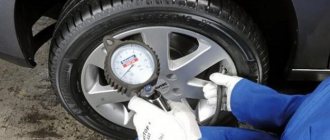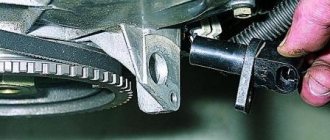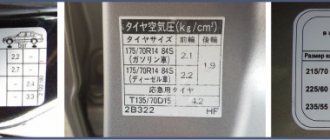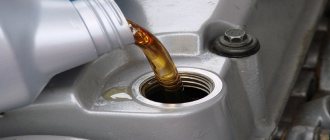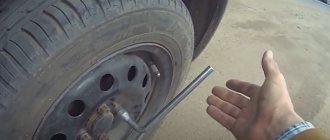Hi all! The topic of our conversation today will be engine oil pressure. The question is quite serious, since in many ways this parameter affects the safety and service life of the power unit on your car.
If you do not want to risk the integrity of the motor, and also do not want to face expensive repairs, I strongly recommend reading this material.
As always, you can ask questions and leave your comments. If you have encountered situations where the pressure was weak, or it was increased, as the measurement showed, write and tell us how you eliminated these problems.
Danger of incorrect pressure
All car manuals will say that the pressure should be normal. But it is not always specified how this parameter is measured, what it depends on and how to raise it if it has dropped, or how to reduce it if it has risen. And what does this norm even mean? Let's figure it out.
As you can see, there are a lot of questions. It is unlikely that I will be able to give a detailed description of literally each of them. That's why we need your help. If you have ever worked with engines like FE-E, 6G72, YaMZ 236, 238, or the same ZMZ 409, it would be a good idea to leave your comment.
As for what the correct pressure should be, I’ll say it simpler first. It shouldn't be high or low. Average Because:
Motor oils for worn-out internal combustion engines
In addition to new cars on the roads, there are those with mileage of several tens of thousands of kilometers. For cars manufactured in Western (Germany, France, Great Britain, Italy, Sweden, Czech Republic) and Eastern countries (South Korea, Japan, China), a mileage of 100 thousand km is not critical. The service life of modern vehicles often exceeds 200...300 thousand km. Domestic cars' mileage is also close to imported products. But for everyone, with use, the gaps still increase.
For vehicles with high mileage, lubricant manufacturers produce special oils. They contain additives that promote sealing in gaps. Working fluids, after being poured into the engine crankcase, ensure operation in conditions close to optimal.
How to convert a trailer to transport a boat with your own hands
- High pressure. If it turns out to be too high, this will lead to the penetration of lubricant, that is, engine oil, into other components of the power unit. And this is not good, since this liquid should not go beyond the elements that need lubrication. The result is damage and expensive repairs;
- Low pressure. If it is low, there is nothing good about it either. The motor begins to wear out faster and overheats greatly due to a lack of lubrication. Details are literally destroyed. Engine jamming in such a situation is a matter of time.
As soon as the light on the dashboard that is responsible for the pressure in the engine lights up, you need to take action. And it doesn’t matter whether it’s low or high.
It is possible that the sensor simply did not work correctly, or the valve failed. We need to look for the cause and eliminate it.
Everything about engine oil pressure: what it should be, how to measure it
- Danger of incorrect pressure
- Normal values
- What does pressure depend on?
- Verification nuances
Hi all! The topic of our conversation today will be engine oil pressure. The question is quite serious, since in many ways this parameter affects the safety and service life of the power unit on your car.
If you do not want to risk the integrity of the motor, and also do not want to face expensive repairs, I strongly recommend reading this material.
As always, you can ask questions and leave your comments. If you have encountered situations where the pressure was weak, or it was increased, as the measurement showed, write and tell us how you eliminated these problems.
Normal values
What do you think creates lubricant pressure in an engine? Absolutely right, a special oil pump is responsible for this function. It operates from the crankshaft.
Pressure has two normal states.
- At idle engine speed. The engine idles, while the speed is at a low value. Normal pressure is taken to be around 2 bar, or 0.2 MPa. It depends on what units of measurement are used;
- On a hot one, that is, on a warm engine at high speeds. When measuring pressure in such situations in a diesel or gasoline engine, the pressure is usually between 4 and 7 bar. That is, from 0.4 to 0.7 MPa. And this is also considered the norm.
But I will say right away that the norm is a conditional concept. Much depends on what kind of car and specifically what engine you are dealing with.
Finding out the norm for your car is not difficult. For this there is such a thing as an instruction manual. Or any other sources of data about the technical characteristics of the car.
Finding the relevant information will not be difficult, and it does not matter what exactly you are exploiting:
avtoexperts.ru
The service life of the engine and its long-term operation directly depend on the quality of the engine oil and its pressure in the lubrication system. The oil pressure indicator (OP) also serves as a unique indicator of the condition of the engine and makes it possible to determine its service life before major repairs.
In addition, DM in the lubrication system affects the overall safety of the vehicle during its operation. This is explained by the fact that with a decrease in DM, or in its absence, a dry friction mode sets in, in other words, the engine begins to experience oil starvation. As a result, the power unit may jam. If a similar situation occurs while driving, it can have unpredictable consequences.
This is due to the fact that the oil in the engine serves to protect parts from dry friction by creating an oil wedge between the rubbing friction pairs and at the same time also cools the heated parts, removing some of the heat from them. When the DM decreases below the permissible level, the oil can no longer create an oil film between friction pairs, which leads to their intense heating.
In turn, strong heating of the rubbing pairs leads to their scuffing, the working layer of the liners may melt and the power plant will jam.
In the engine lubrication system, oil is supplied to the loaded vapors under the necessary DM created by the oil pump.
Engine oil pressure standards
In a working engine, the minimum pressure in the lubrication system is 0.7 -0.8 atm at idle and about 3–4.5 atm in power mode. At idle, the engine speed is in the region of 750–1000 rpm, which does not require high pressure.
When the pressure drops below the set value, the emergency pressure light (oil can symbol) lights up on the instrument panel.
While in motion, the speed of the power plant increases, the load on all parts increases, and the rubbing pairs require higher pressure in order to stably maintain the oil film between the contacting parts.
Pressure value and engine operation
Any deviation from the factory DM standards negatively affects engine performance, regardless of whether it decreases or increases.
As mentioned above, when the pressure decreases, oil starvation of the friction pairs occurs, which is fraught with engine jamming. In addition, a decrease in pressure leads to rapid wear of the motor.
Increased pressure negatively affects all connections, causing leakage of seals and gaskets and squeezing out of seals.
Operating principle of pressure devices
Depending on the design of the power unit, one or two pressure sensors can be installed.
First option.
This is an emergency pressure sensor that is triggered when the pressure drops below the established norm. The sensor works in tandem with a pressure light that lights up when it decreases.
Second option.
This sensor can also be installed in conjunction with a pressure indicating sensor, the data of which is displayed on a pointer on the instrument panel. The index, in turn, can be made in the form of digital values in kg/cm2, or in the form of graphic color images. Usually these are green and red zones, where the red sector indicates that the pressure in the system is higher than normal.
When the pressure decreases, the emergency pressure sensor will operate and a light will light up on the instrument panel, which may also be accompanied by a warning sound.
Disadvantages of a lubrication system equipped only with a pressure light.
The lamp on the instrument panel may not be activated even if the oil level in the engine sump is significantly reduced. Plus, the lamp may not light up even if the pressure drops, when it is not critical.
However, during prolonged operation of the engine at a pressure even slightly lower than required and insufficient oil level, partial rupture of the oil film occurs in the friction pairs, which leads to their rapid wear.
The driver in this situation, since the pressure light goes out after starting and does not light up while driving, will not be able to react to the decrease in pressure and take timely measures to restore it.
To avoid such situations, it is recommended to periodically check the condition of the DM by measuring it using a mechanical pressure gauge.
You can also independently install a sensor and pointer on the instrument panel paired with a light bulb in order to always have complete information about the pressure in the system.
Pressure check
Car owners often wonder what pressure in the engine will be normal, as well as what its parameters are on a cold and warm engine. Car enthusiasts are especially concerned about the issue of pressure when the lamp begins to blink when the engine warms up at low speed or does not go out for a long time when warming up.
Before starting the test, you need to find data on a specific engine in the car manual so that you can compare the results.
To check, you need to purchase a special pressure gauge and adapter.
Roof rack for cars: which one to choose
- Lada Priora 16 valves;
- KAMAZ;
- VAZ 2114;
- Chevrolet Niva;
- VAZ 2106;
- Mercedes 190;
- Mazda 6;
- Lada Kalina 1.6 8 valves;
- VAZ 2112, etc.
If we take the same device, then in idle mode the norm is 2 bar. But raising the speed to 5000-5500 rpm, the norm rises to 4.5-6.5 bar. If it’s higher, then it’s already bad.
What does pressure depend on?
Also an important question. There are several main factors that directly influence the determination of the normal pressure level in the engine oil system.
Experts have different opinions on this matter. Some people think one position is correct, others think differently. But we can say that the following factors play a role:
- number of cylinders on the car;
- the number of valves used on the engine;
- number of horsepower;
- engine power;
- use of diesel fuel;
- use of gasoline;
- volume of the power unit;
- geometric dimensions of the motor;
- type of oil used, etc.
It happens that you are quietly driving your car, and suddenly the oil pressure control lamp lights up on the dashboard. That is, the operating condition is disrupted, and the warning light blinks, informing you of a potential threat.
There is a specific reason for this. You need to look for her. Perhaps the pressure did not disappear, but the sensor itself simply failed. The pressure is weak, or, on the contrary, increased for various reasons. But basically we are talking about a malfunction of the oil pump, or about depressurization of the system.
Violation of system tightness
This could be a seal leak, causing some of the oil to leak out. The problem is accompanied by oil burns. Moreover, the lubricant does not burn in the cylinders (as happens when the rings are stuck and the piston is scuffed), but simply flows out. This malfunction is typical for engines with a mileage of 150 thousand kilometers. This can be solved by installing a new crankshaft oil seal. Please note that there are several of them - front and rear. Also, when replacing, the oil and filter are changed. After this, the problem goes away by itself.
What to do if the lamp is on?
As we said earlier, a special indicator lamp will indicate low pressure. What are our actions if we find ourselves in such a situation? First of all, you need to turn off the engine. Next, open the hood and check the oil level. It also happens that the lamp lights up due to its low level. If the dipstick is normal, you need to look deeper for problems. But this must be done in a garage or service center. It is better to get to the repair site by tow truck.
When is a burning lamp normal? It only appears like this after a cold start. In the first seconds, the pump cannot yet generate the required pressure. But if the motor has been running for 30-50 seconds, this clearly indicates a problem.
Helpful advice
Oil pressure is also affected by its viscosity. Do not use too thick oil for the winter. Firstly, it will make it difficult to cold start the engine. Secondly, it is possible that the pressure drops 20-30 percent below normal.
If you have a car with more than two hundred miles, you should not pour too thin oil (for example, 0W30). Yes, it makes it easier for the engine to start. But due to worn oil seals and gaskets, most of it will leak out. There are often cases when it took up to three liters of oil to top up. In this case, the best option is 10W40.
